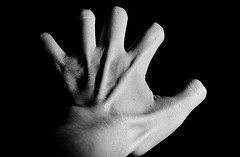Hand Anatomy 101

This is a guest post by Michelle Davis, an artist, graphic designer and medical illustrator.
The muscles that control the hands and wrist can be broken down most easily into extensors and flexors, and of course, these groups can be further broken down. Ironically, relatively few of these muscles insert and originate in the hand (what I’ll call intrinsic hand muscles) — the rest are purely tendons by the time they get travel through the wrist.
Before digging in, we need to do a quick primer on some medical terminology that helps in understanding names and locations of muscles. All these terms are relative, and similar to anything you’re familiar with in weightlifting. And they’re all pretty self explanatory.
anterior = front
posterior = back
medial = toward middle
lateral = toward outside
flexor = a muscle that flexes, usually bringing body parts inward. example: making a fist
extensor = the opposite, usually distancing body parts and moving them outward. example: splaying fingers for high five
distal = far out
proximal = closer to center
abduction = away from center
adduction = together, or toward center
carpals = wrist bones
metacarpal = hand bones
phalanges = finger bones (distal, middle, and proximal except in thumb)
dorsal = refers to back of hand
The insertion end is attached to a bone which a muscle will move when it is contracted.
The origin end is attached to the bone which does not move.
The flexors originate on the anterior forearm, on the medial side of the elbow joint. In other words, when you hold your arm palm up, these muscles are coming from the inside of the elbow.
4 layers from superficial to deep:
- These insert on or close to the wrist, and flex the hand and move it side to side.
- flexor carpi radialis
- palmaris longus
- flexor carpi ulnaris
- Insertion on middle phalanges. This one flexes the fingers.
- Flexor digitorum superficialis
- These reach to the finger (and thumb) tips.
- Flexor pollicis longus — flexes the thumb
- Flexor digitorum profundus — flexes the fingers
- Pronator quadratus — this one turns the wrist over.
The extensors compliment the flexors — they originate on the posterior side of the forearm and/or the lateral sides of the radial and ulna. Hold your hand palm down and its the little bit of meat facing toward the ceiling.
- Superficial Layer
- Extensor carpi radialis brevis and longus — extends the hand, and attaches on the metacarpal of the index and middle fingers
- Extensor digitorum — extends the fingers
- Extensor digit minimi — extends the pinky finger, and attaches to the little finger
- Extensor carpi ulnaris — extends the hand, and attaches to the pinky finger metacarpal.
- Deep Layer
- Supinator — turns forearm/wrist over
- Extensor indicis — extends the index finger
- Additional muscles
-
- Abductor pollicus longus — moves them away
- Extensor pollicis longus — extends the thumb, and inserts on proximal thumb phalanx
- Extensor pollicis brevis — extends the thumb, and inserts on distal thumb phalanx.
Finally, there are the intrinsic hand muscles. Just to make things confusing, most of them have the same words in them as other hand muscles, just in different orders. On the up side, if you think about what those words mean, you’ll immediately know how that muscle acts.
- Thumb (“thenar”) muscles: start from the palmar side of the wrist and insert on parts of the thumb. “Pollicis” also means thumb.
- Abductor pollicis brevis — moves thumb away
- Flexor pollicis brevis — flexes thumb
- Opponens pollicis — moves thumb toward pinky
- Pinky finger (“hypothenar”) muscles: start from the pinky finger side of wrist and insert on 5th metacarpal or finger.
- Abductor digiti minimi — moves pinky finger away
- Flexor digiti minimi — flexes pinky finger
- Opponens digiti minimi — moves pinky finger toward thumb
- Central compartment muscles: these ones run in the depths of your palm.
- Adductor pollicis — brings thumb in toward palm.
- Lumbricals (4) — supports flexion of the hand and extension of the fingers.
- Interossei (4 dorsal, 3 palmar) — lets you spread and close your fingers. They’re between your metacarpals and insert onto on the fingers.
So! The control of our hands is a complex process, and I didn’t even delve into nerves, vascular supply, or joints. If my count is right I just listed 36 muscles controlling the hand and wrist movement – and, as a guitarist, you know there’s some impressively fine control available. There definitely aren’t that many muscles controlling thigh movement.
Image References for hand anatomy:
http://education.yahoo.com/reference/gray/subjects/subject/126
http://anatomy.med.umich.edu/musculoskeletal_system/hand_tables.html
http://en.wikipedia.org/wiki/Hand
http://www.theodora.com/anatomy/the_muscles_and_fasciae_of_the_hand.html

Guest Post - hand anatomy for guitarists | Visualizing the Biological
[…] written a guest post describing hand anatomy over at The Classical Guitar Blog. It focuses on hand muscles, and few details are spared — part of the beauty of how the hands […]
Pat
This was a great synopsis of the anatomy of the hand. Thanks for posting. It will be very useful to musicians.